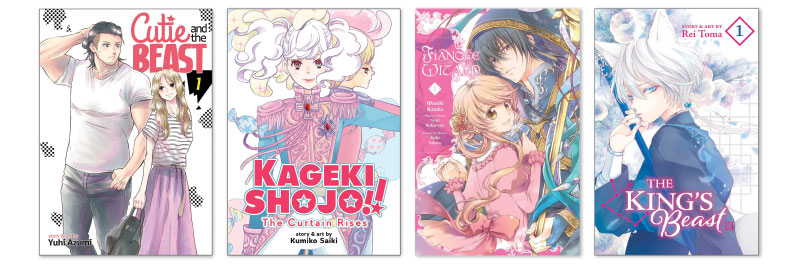Shoujo Manga Is Back: 8 New Comics Made for Girls
Geared for teen and tween girls, here are recommended new titles in shoujo manga, with interesting twists on the standard tropes.

When it first started appearing in North America in the late 1990s and early 2000s, shoujo manga gave American girls something they hadn’t seen in decades: comics that were just for them.
Tailored for tween and teen girls and readily available in bookstores, shoujo manga quickly found an audience. Readers snapped up series such as “Fruits Basket,” “Sailor Moon,” and “Boys Over Flowers.” Graphic novel sales soared, and many early fans, such as Svetlana Chmakova, went on to become comics creators themselves.
The word shoujo literally means “girl,” and in Japan, shoujo manga is simply manga for teen and tween girls. The category spans a variety of genres, including high school romance, fantasy, and action tales. Certain plot elements appear over and over. Popular elements include a girl surrounded by cute boys who are all interested in her; a girl and boy who have to live under the same roof; the childhood friend who becomes a love interest; and the girl who must disguise herself as a boy to lead an army or attend an all-male school.
Shoujo manga can be quite complex to read because the character’s inner monologue often appears alongside the spoken dialogue. The dialogue is in word balloons—with or without tails—and the character’s thoughts are presented in boxes or as borderless text that drifts across the pages with a profusion of ellipses. Some manga actually have two different threads of inner monologue, one lettered in a larger size than the other.
Another visual characteristic of shoujo manga is its more-is-more approach. Many manga creators crowd their panels and backgrounds with details, including tiny drawings of the characters (chibi), explosions of shapes and screentones, and huge drifts of flowers. Think of the inside of a middle school student’s locker door, plastered with stickers and photos. On the other hand, some manga take a more austere approach, leaving plenty of white space to emphasize the characters and their feelings. And shoujo manga is all about feelings.
Shoujo manga has a lower profile now than in the mid-2000s, when volumes of “Fruits Basket” often appeared on USA Today’s Top 100 best sellers list. Manga sales plummeted in the late 2000s, and when they came back, shonen (boys) manga were the most popular, often driven by anime. Furthermore, manga has the same asymmetry with regard to readership as other books: More girls read shonen manga than boys read shoujo. Still, all the major manga publishers have robust shoujo lines, and Viz even has a separate imprint, Shojo Beat.
While classic series such as “Ouran High School Host Club,” “Maid-Sama,” and “Yona of the Dawn” (all from Viz) continue to be popular, publishers have plenty more new shoujo titles lined up, some with interesting twists on the standard tropes. Here’s a look at eight recent shoujo series that are worth a look.

“Cutie and the Beast.” Yubi Azumi. Seven Seas.
Gr 8 Up –Momoka is a fan of professional wrestling, and the wrestler she likes best isn’t a handsome ladies’ man but a gorilla of a guy, Kuga, whose fans are mostly men who want to try a wrestling move with him. Despite his intimidating presence in the ring, Kuga is really a gentle giant with a pet rabbit and a good heart. At first the two communicate on Twitter, but things heat up after Momoka sends a fan letter with a photo and then meets Kuga after a bout. Sparks fly fast, but Kuga hesitates when he learns she is only 18; at 29, he’s afraid he is too old for her. Momoka won’t take no for an answer, though. This is the sort of thing that would probably end badly in real life, but the characters are so earnest that the first volume, at least, is very wholesome. A similar dynamic without the age difference is “My Love Story” (Viz, 2013-7), a high school rom-com about a girl who falls for a brawny, bighearted guy.
“Fiancée of the Wizard.” Syuri Nakamura and Keiko Sakano. Illus. by Masaki Kazuka. Yen Press.
Gr 8 Up –This is an isekai manga (in which the hero is reborn in another world): The six-year-old daughter of a noble family wakes up from an illness with the realization that she is the reincarnation of a woman who died in modern-day Japan. Filimena has the mind of a 30-year-old and a good sense of how things work in RPG fantasy worlds, but she isn’t called on to be a hero. Instead she becomes childhood friends with Edy, a boy whose dark hair signifies that he will be a powerful magician. After an incident that scares both of them, Edy is sent away to school, but before he leaves, they get engaged. When they reach adulthood, Edy’s inability and unwillingness to express his feelings leave Filimena confused and sad, but after Edy is presumed dead in an epic battle, he returns for a happy ending. This story arc is complete in the first two volumes, but the series continues after that. The art is classic shoujo fantasy style, filled with frills, flowers, and flowing hair.
“Kageki Shojo!!: The Curtain Rises.” Kumiko Saiki. Seven Seas.
Gr 8 Up –The Takarazuka Revue is an all-female musical theater troupe that is famous for its adaptations of the classic manga “Rose of Versailles” and other stories. “Kageki Shojo!!” is set in a school that trains performers to join a similar troupe, and it follows two students: Narata Ai, a former teen idol who wants to shut herself off from human contact after a disturbing incident with a fan, and Watanabe Sarasa, who is tall, earnest, naive, and endearingly goofy. The other students are both friendly and competitive, with the older students mentoring the younger class, so there’s plenty of drama, including story lines about bulimia and childhood sexual abuse. The art has a retro feel, with occasional visual allusions to “Rose of Versailles,” and the characters’ faces and gestures are very expressive, even when drawn simply. Besides being a cracking good soap opera, this manga offers interesting tidbits about Japanese theater. The story is complete in one volume and is a prequel to the main “Kageki Shojo!!” series, which Seven Seas will publish starting in July 2021.
“The King’s Beast.” Rei Toma. Viz.
Gr 8 Up –This fantasy series is set in the same universe as Toma’s earlier series, “Dawn of the Arcana,” but the story stands on its own. In this world, which is loosely based on ancient China, humans are served by Ajin, creatures who have supernatural powers. Because the Ajin are a minority, they are dominated by the humans, forced to act as slaves (or prostitutes, in the case of young women), and denied basic rights. Rangetsu, an Ajin, disguises herself as a man and becomes a servant in the court so she can avenge her brother’s murder. She believes he was killed by her master, Prince Tenyou, but when she learns that is not true, and that the prince in fact mourned her brother’s death, she resolves to stay with the prince while she hunts for the murderer. Toma is also the creator of “The Water Dragon’s Bride” (Viz).

“Not Your Idol.” Aoi Makino. Viz.
Gr 11 Up –Less of a romance than a psychological drama (at least in the first two volumes), this is the story of Nina Kamiyama, a former teen idol who quits her group, reverts to her real name, and goes back to school after being attacked by a fan. Traumatized and scared, she wears a boy’s uniform and gives everyone the cold shoulder, but one of her fellow students has figured out who she is. Makino does a good job of keeping the reader guessing as to whether he’s really as nice a guy as he seems, while surrounding Nina with an intriguing cast of other characters, each of whom has his or her own agenda. One of the interesting things about this manga is the way the characters discuss gender roles, sexual harassment, and objectification: It’s not heavy-handed but does offer food for thought. The art is dark and detailed, but the story moves fast. The first volume of this series was one of SLJ’s Top 10 Manga of 2020.
“Prince Freya.” Keiko Ishihara. Viz.
Gr 11 Up –A weepy yet capable young girl must take the place of a dying prince in order to defend her country and her village in this action-filled story. Freya’s two foster brothers are part of the prince’s guard, helping defend not only the prince but also their country, which a neighboring country plans to invade and occupy. As it happens, the prince and Freya look exactly alike, so when he is killed by a poisoned arrow, she must jump in on short notice and take his place. She’s agile and capable, but she also has a tendency to break down in tears at the slightest provocation. After her older brother is killed before her eyes, however, she resolves to be strong and step into the role of prince. This means not only keeping her village safe but also dealing with the complex politics of the royal court, where nobody is exactly what they seem to be. This action-filled manga is drawn in an energetic style similar to shonen series such as “Naruto”; the author is also the creator of “The Heiress and the Chauffeur” (Viz).
“A Sign of Affection.” suu Morishita. Kodansha Comics.
Gr 11 Up –Yuki is savoring her first year of college, a huge change from the small school for the Deaf she attended up to then. Although she wears a hearing aid, she communicates mostly via sign language, lipreading, and writing. Itsuomi, a globetrotting third-year student, rescues her from an awkward situation, and soon romance begins to blossom, with encouragement from Yuki’s outgoing friend Rin (who has a crush on Itsuomi’s cousin). Yuki feels comfortable with Itsuomi and likes the way he acts natural around her, rather than overly protective like her childhood friend Oushi. Morishita, the creator of “Shortcake Cake,” shuns busy backgrounds and crowded panels, focusing instead on the characters and their feelings. She worked with a sign language consultant for this manga, which uses Signed Japanese, and she adds information about sign language in explanatory notes between chapters.
“Star Crossed!!” Junko. Kodansha Comics.
Gr 11 Up –It’s Freaky Friday, but with a teen idol and his biggest fan as the protagonists. Teenager Azusa is thrilled to be in the front row of a concert featuring the idol group Prince 4 U. Suddenly, a row of lights falls from the ceiling over the head of her favorite singer, Chika. She pushes him away, but they are both crushed by the heavy apparatus. When they arrive in heaven, God (drawn as a plump old man with a beard) admits there has been a mistake and returns them both to life. Unfortunately, mistakes are made, and they return in each other’s bodies. This leads to all sorts of awkwardness, especially at bath time, but it also gives them an excuse to be together and for Chika to move into Azusa’s apartment building and attend her school. This is thrilling for Azusa, but it raises the hacklers of her childhood friend, who nurses a serious crush on her. The series, by the creator of “Kiss Him, Not Me” (Kodansha Comics), is complete in four volumes.

Add Comment :-
RELATED
Heidi: A Graphic Novel
Daybreaker
Speak Up, Santiago!
The job outlook in 2030: Librarians will be in demand
The job outlook in 2030: Librarians will be in demand
ALREADY A SUBSCRIBER? LOG IN
We are currently offering this content for free. Sign up now to activate your personal profile, where you can save articles for future viewing





